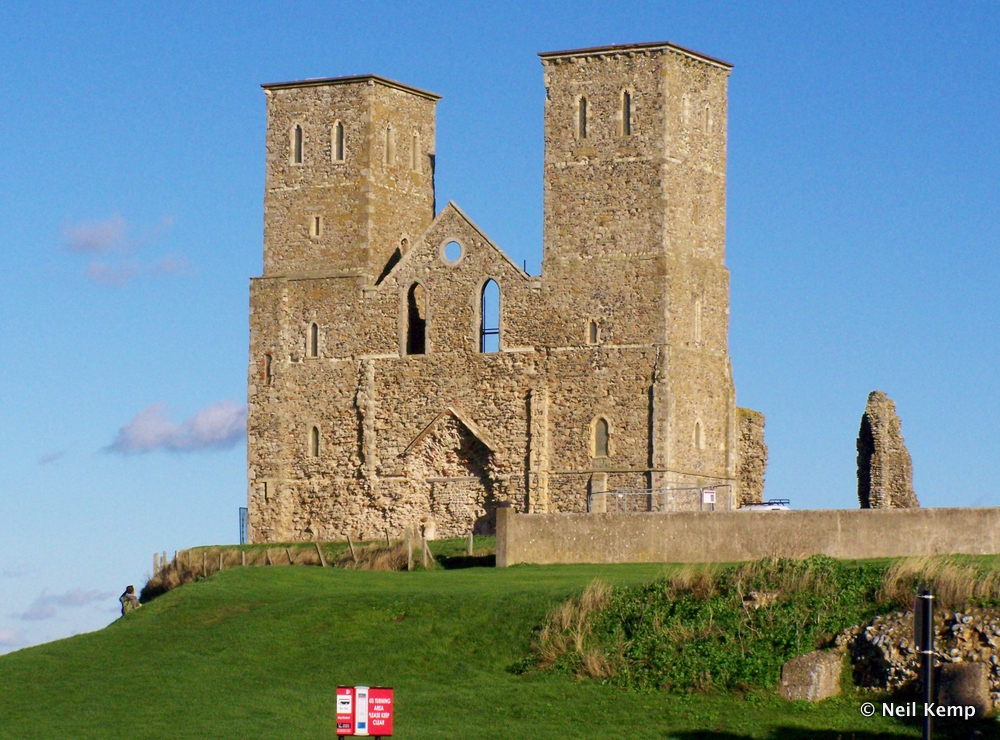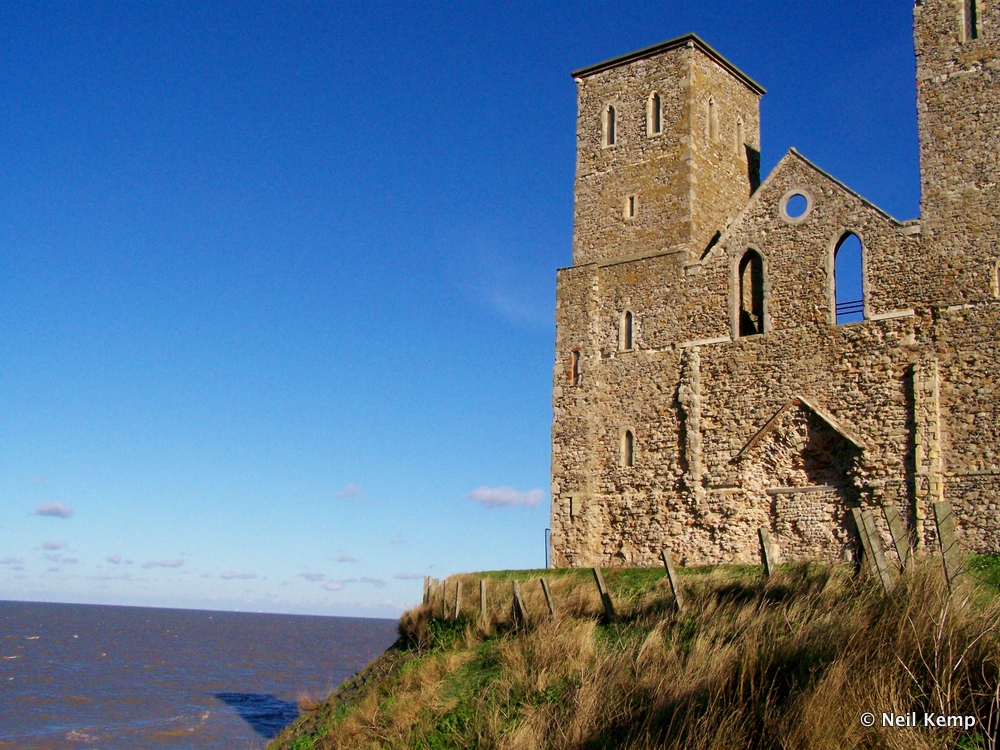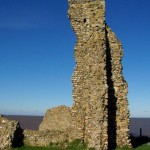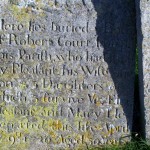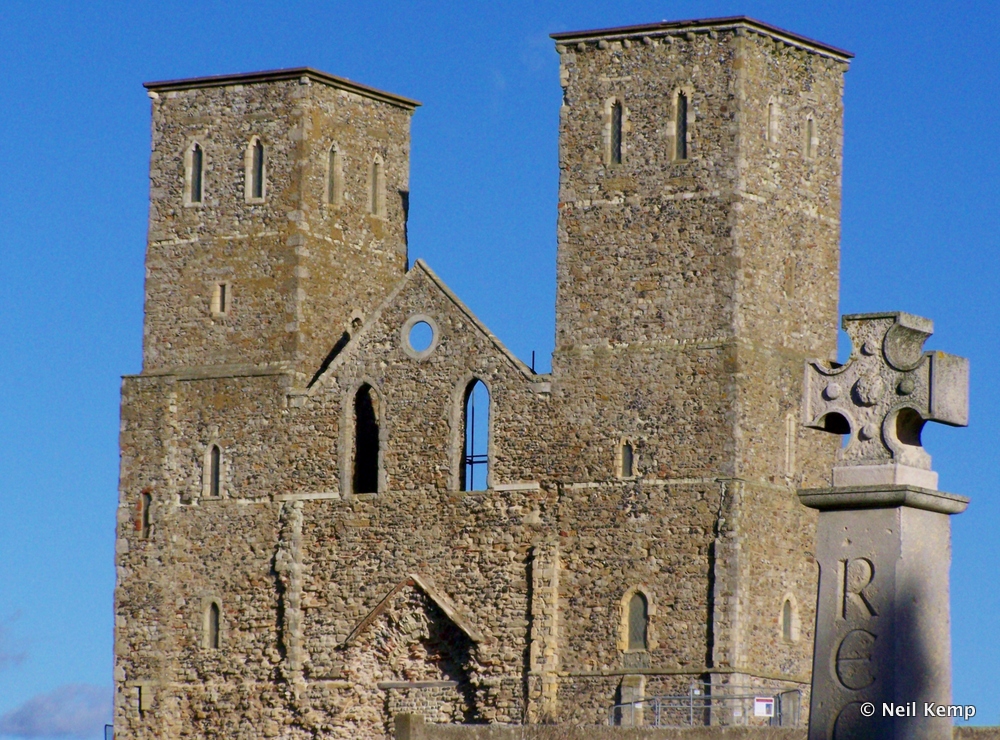
This week’s travels took me to another Roman site, the fort at Reculver.
A Roman settlement was established at Reculver shortly after the invasion of AD 43 and a small defensive area was set up on the headland, probably containing a signal station or lighthouse. Future settlements prospered during the first and second centuries, and during the early part of the 3rd century a fort was built, both in order to protect the Roman settlement and to defend the northern entrance to the Wantsum Channel, a vital strategic link for Roman shipping travelling to and from London and the continent.
 Reculver, or Regulbium as it was known to the Romans, is situated at the northern promontory of the Wantsum Channel, where it joined the Thames Estuary, and the threat of sea-borne raiders was thought so great by this time that a permanent defensive structure was built-in the form of a fort that was nearly 600 feet square. The flint walls were protected by earth ramparts and two large ditches, the traditional design for the early round cornered Saxon Shore Forts. Some years later a fort was built at Richborough to defend the southern entrance to the Wantsum which incorporated the new model projecting bastions and triple ditch defences.
Reculver, or Regulbium as it was known to the Romans, is situated at the northern promontory of the Wantsum Channel, where it joined the Thames Estuary, and the threat of sea-borne raiders was thought so great by this time that a permanent defensive structure was built-in the form of a fort that was nearly 600 feet square. The flint walls were protected by earth ramparts and two large ditches, the traditional design for the early round cornered Saxon Shore Forts. Some years later a fort was built at Richborough to defend the southern entrance to the Wantsum which incorporated the new model projecting bastions and triple ditch defences.
The fort at Reculver was abandoned in the early part of the 5th century after the departure of the Romans and fell into disuse. Reusing the existing defences, an Anglo-Saxon monastery was established on the site in 669 and the church of St Mary was built at the centre of the old fort. The monastic house ceased to function by the 10th century and the church then became the parish church of Reculver. Remodelling of the church during the 12th century included the addition of tall twin towers.
Although originally some distance from the cliff edge, coastal erosion had brought the sea closer to the church by the beginning of the 19th century and it was mainly demolished in 1805; the stone from the old church being partially reused to construct a new church on higher ground at Hillborough. The twin towers were left as they were a vital navigational aid to shipping and were bought, repaired and underpinned by Trinity House in 1809 in order to safeguard them in this function.
The twin towers still survive amidst the ruined remains of the old Roman fort and even today make an imposing monument against the sea on one side and the flat marsh lands of the now completely silted Wantsum on the other. It is hard to believe, given that the once might Wantsum is now little more than a drainage ditch, that the channel separating Reculver from the Isle of Thanet was over two miles wide during the Roman occupation. As this channel has now disappeared, it is rather ironic that the sea has taken most of the fort due to coastal erosion at the old mouth of the Wantsum and it is only the implementation of coastal flood defences that have allowed the towers to remain.

At the time of the Roman landings Britain was considered to be at the very edge of the known world. Today, whilst our knowledge of the world may have expanded, the towers at Reculver stand very much on the edge of their own small world and, despite the defences now in place, one cannot help but wonder how long they can cling onto this precarious vantage point.
Reculver has had many stories of supernatural experiences and it is said to be one of the most haunted places in Kent, with the sound of children crying being the most reported phenomena experienced there. I don’t know about that, but it is a desolate and empty place and I do know that it certainly isn’t a venue to be wandering around the old gravestones after dark, that’s for sure.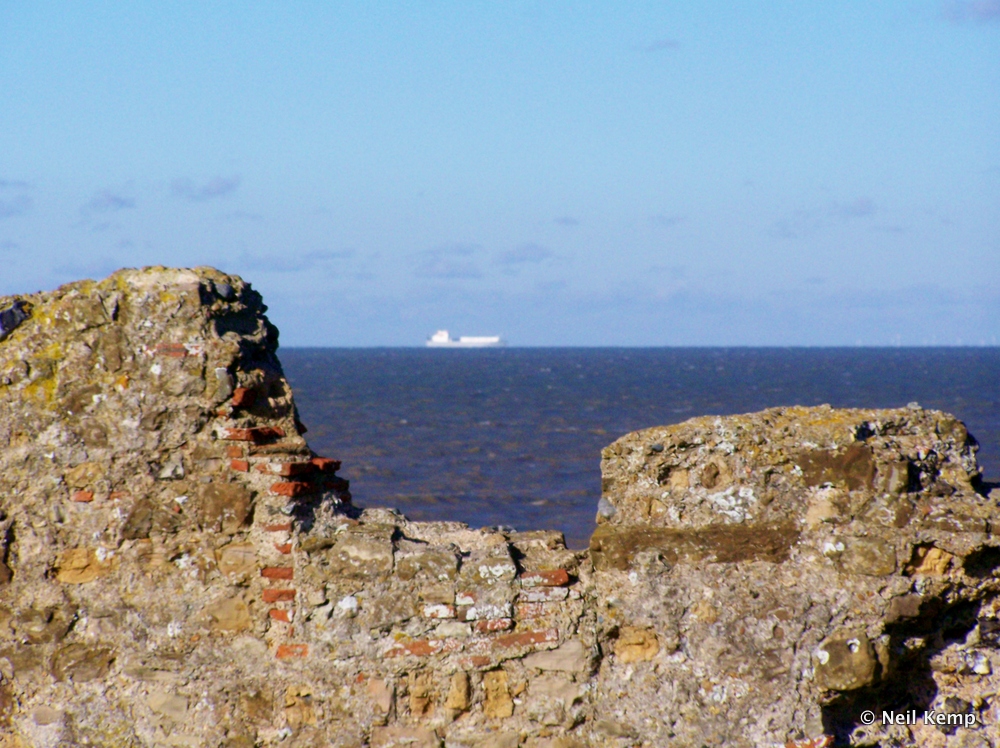
According to legend, a ship carrying two sisters, Frances and Isabella, ran aground at Reculver during a heavy storm, Frances was rescued, but Isabella (who had been betrothed to Henry de Belville; fatally wounded fighting for Richard III at Bosworth Field in 1485) did not survive. Despite this personal tragedy, Frances (who was a nun) restored Reculver Church and added spires to the towers, which were known thereafter as the Twin Sisters. Sadly, the spires also disappeared soon after the demolishing of the church in 1805. Does the spirit of the displeased Frances haunt the old church after dark? I doubt it very much, but I wasn’t about to hang around to find out, thank you very much.
Another note of interest regarding the former church at Reculver is that the twin towers and west front of St John’s Cathedral at Parramatta, Sydney, Australia are based on the same design and were added to the existing cathedral there by 1818.
 Reculver is a bleak and isolated location and probably not best viewed in November with a gale blowing from the sea. Despite this I would recommend its viewing, as it remains a somehow fascinating place to visit, despite being little more than ruins. An interpretation centre is only some 150 yards away, but has limited opening times and then only at weekends, except for school holidays and Easter.
Reculver is a bleak and isolated location and probably not best viewed in November with a gale blowing from the sea. Despite this I would recommend its viewing, as it remains a somehow fascinating place to visit, despite being little more than ruins. An interpretation centre is only some 150 yards away, but has limited opening times and then only at weekends, except for school holidays and Easter.
On a warm summer’s day, with perhaps a light sea breeze, it would make an ideal location for a picnic, especially as there is no charge to walk around the site or its surrounding lands.
I would put forward just one further recommendation; make sure you leave before darkness falls.
Neil Kemp is a keen and passionate amateur historian and prize winning photographer who lives in Margate, on the North Kent coast in the United Kingdom. Before retiring he worked both with and at Margate Museum, overseeing budgets on a number of historical projects.

